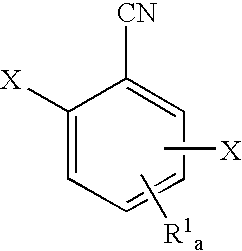Polyarylethernitrile hollow fiber membranes
a polyarylethernitrile and membrane technology, applied in the field of hemodialysis and hemofiltration, can solve the problem of insufficient hydrophilicity
- Summary
- Abstract
- Description
- Claims
- Application Information
AI Technical Summary
Benefits of technology
Problems solved by technology
Method used
Image
Examples
example 1
Polyarylethemitrile Preparation
[0052]
[0053]Under nitrogen atmosphere N,N-dimethylacetamide (DMAc) (500 mL) and K2CO3 (400.08 g, 2.8949 mol) were charged into a 5000 mL-reactor. Bisphenol-S (361.90 g, 1.4460 mol) was added and rinsed in with DMAc (1100 mL). Over the course of 2 days about 2350 mL of toluene was added in portions and distilled out to dry the reaction mixture. Then, 2,6-difluorobenzonitrile (196.85 g, 1.4151 mol) plus more toluene (525 mL) was added. During the subsequent polymerization toluene kept distilling at a constant rate (˜2.5 ml / min). After 5 h, the weight average molecular weight (Mw) was 80,000 g / mol (Polydispersivity=1.6) was high enough and the mixture was diluted with DMAc (3200 mL) and the polymer was drained from the reactor, precipitated into water, filtered and rinsed with water. The resulting white fluffy powder was reslurried with water, filtered and slurried again with methanol. After filtration and drying in the vacuum oven 450 g (89% yield) of a ...
example 2
[0059]Preparation of a Porous Polyarylethernitrile Membrane: The polyarylethernitrile from Example 1 was dissolved in NMP to produce a 20 weight % solids solution. The solution was cast onto a glass plate using a 10 mil casting knife. Porous membranes were produced by immersing the films immediately into water at room temperature. Scanning electron micrograph (SEM) of the sample was obtained and demonstrated that porous membranes were formed from the polycyanoether nitrile.
example 3
[0060]To a 20 wt. % solution of Example 1 was added 20 weight % polyvinylpyrollidinone (Number Average Molecular Weight (Mn)=100,000 g / mol). The solution was cast onto a glass plate using a 10 mil casting knife. Porous membranes were produced by immersing the films immediately into water at room temperature. Scanning electron micrographs (SEM) of the sample was obtained and demonstrated that porous membranes were formed from the polycyanoethernitrile / polyvinylpyrollidinone blend.
PUM
| Property | Measurement | Unit |
|---|---|---|
| pore size | aaaaa | aaaaa |
| pore size | aaaaa | aaaaa |
| pore size | aaaaa | aaaaa |
Abstract
Description
Claims
Application Information
 Login to View More
Login to View More - R&D
- Intellectual Property
- Life Sciences
- Materials
- Tech Scout
- Unparalleled Data Quality
- Higher Quality Content
- 60% Fewer Hallucinations
Browse by: Latest US Patents, China's latest patents, Technical Efficacy Thesaurus, Application Domain, Technology Topic, Popular Technical Reports.
© 2025 PatSnap. All rights reserved.Legal|Privacy policy|Modern Slavery Act Transparency Statement|Sitemap|About US| Contact US: help@patsnap.com



